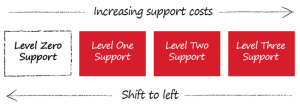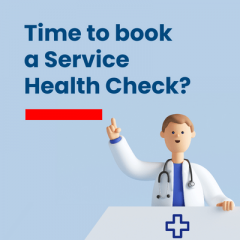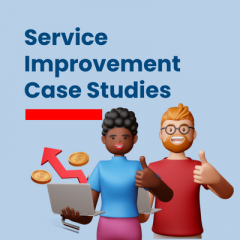We asked Stuart Beale, the ICT Customer Support Team Manager at Leicestershire County Council, some questions about the move to shift left for their service desk. Read on to discover the key to their shift left success.
What were your motivations and influences?
About two and a half years ago, I joined Leicestershire County Council as a service desk manager. I was very fortunate to be in a position where there was a very clear need for a reduction in costs and efficiency saving on the service desk. There was a plan and entitlement from the County Council and IT Services to make efficiency savings.
My direct line manager and Head of IT Services was very clear about what needed to be done to achieve this; including reducing the number of contacts to the service desk by 50%. While this was a high target to achieve, County Councils are affected significantly by austerity, which gave a level of urgency to the project.
Furthermore, our Service Management tool was in need of renewal, which gave me an opportunity to make all of our processes more efficient. One of the things that I did was set a benchmark for the service desk. We had a very good level of metrics recording, and at that point in time, we were a part of the SDI Service Desk Certification programme. We were using this to make our service desk service consistent and to improve quality. Benchmarking the service desk allowed us to realise that we had some very good metrics, KPIs and statistics, so I knew exactly where the service desk’s inefficiencies were.
How did you get the project into action?
Once I set a benchmark, it became clear that there were areas which had become inefficient. One of those areas was the bouncing of emails. When an email was sent to the service desk it often did not have all the right information on it, or it would be too vague. For example the customer would email saying their system is broken, and then the service desk would need to go back and forth over email to elicit the right information from the customer. This often would create a 5 or 10 long email chain. This had a huge impact on resources and productivity, and it is just generally inefficient. Therefore this was an area that I knew I could improve.
The second area that I identified for improvement through our metrics was use and effectiveness of our self-service portal. Our portal was quite poor, and the number of forms and the design of the forms was weak.
We took those two areas and then looked at what we could convert from email to portal. We looked to identify the most frequent requests and incidents that were coming to the service desk, and we converted those to a portal form. We then ended up with around 50 forms from all the information we gathered. Additionally, we promoted and marketed the portal, and made the decision that anything that came through the portal would be a higher priority than email, whilst also encouraging and supporting the service desk staff to push customers to go through the portal.
Consequently, we managed to get good buy-in and uptake of the portal, which basically did two things; it collected all the data up front, and completely killed the email ping pong that we had going on, effectively making this a “shift left” from the first line of the service desk to the customers.
Shift left is not a silver bullet – there are a few things that cannot be achieved with it. For example, you cannot get a customer to fix their own incident; this is the job of the service desk. However, what you can do is ask customers to take a bit more responsibility, to fill a form in and to make a request, which gives us all the information to help us meet the customer’s needs.

How did you market the tool and its success?
We marketed the tool by setting up a pop up stand in a corridor that runs to the café. I manned it with some very outgoing and enthusiastic members of the service desk who weren’t afraid to step out in the corridor and capture people’s full attention. We put on a bit of a show whereby we introduced the portal, what it was going to do, how easy it was to use, and how it would improve the service that the service desk provides.
Prior to the new portal, user take up of self-service was 1%, whereas now we have close to 30% usage of portal, and email usage has dropped to almost 20%, with the remaining 50% being telephone contacts. With regards to our success rate, we have peaked at 44% reduction in contacts to the service desk; there were 10,000 contacts to the service desk a month, and now we are a little over 6000. Furthermore, I made sure that all of the time that was tied up in those 4000 contacts was divided up into proactive support, knowledge base creation, and providing training to our staff and customers.
How do you create a proactive service desk?
We use the time saved to regularly run a report to see when people are getting close to the email inbox storage limit. We call them and sit down with that staff member to go through how they can manage their mailbox more effectively. Additionally, we do an assessment, and if we feel that the person’s role or position requires a larger mailbox, we put in a request on the behalf of the customer to increase their mailbox size.
This has put us in a positive cycle, as the more proactive work we do, the more it builds on our service and reduces the calls to the service desk. So now that we’ve built that time in, we can spend dedicated time building a good knowledge base. For instance, within our portal’s knowledge base, some of our articles have had over 1000 views. This has also led to a reduction of calls to the service desk.
The positivity of the team throughout the process was driven by the fact that we had structure, which can be attributed in some part to the SDI certification, which ensured that stakeholders knew what was expected of them from the marketing and leadership parts of the standard and what we learned from the auditors. We were able to take analysts off the phones and give them some more interesting and valuable work to do, such as expanding the knowledge base or doing some user training. Thanks to this, my team is very happy.
What unexpected outcomes did you come across?
Our staff has now experienced the success of the portal, and non-IT business units now want to emulate what we are doing. This has brought its own complications, as we have to be careful about how we proceed; whether IT services get involved in the procurement, design, and implementation of the portal, or whether we step back and let the business unit design their own.
How will you Shift Left past self-service?
Shift left is all about moving the work to the most efficient area that you can, by using technology, upskilling and redistribution of resources to increase efficiencies in service whilst saving time and money. As such, our phase two and phase three will be to move work from second line into the service desk. Now that there is bandwidth on the service desk for additional work to come in, we can design safeguards into aspects such as an active directory.
Our next phase is to look at what work my applications team can do and what work my infrastructure teams are currently doing and what we can move safely and efficiently into the service desk. Effectively, what I am doing is moving work from a high paid person to a lower paid person. Therefore, what comes out of that is the possibility of cost savings and a redistribution of resources which in turn allows everybody on the team to deliver more business value.























